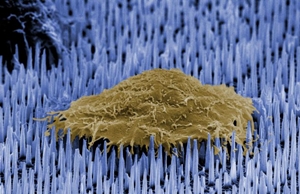31 March 2015. A device made of tiny nanoscale needles successfully delivered genetic material that encourages growth of blood vessels in lab animals, in tests of its therapeutic potential. Researchers from Imperial College London in the U.K. and Houston Methodist Research Institute in Texas reported their findings yesterday in the journal Nature Materials (paid subscription required).
The team led by Imperial biomaterials professor Molly Stevens and professor of nanomedicine Ennio Tasciotti at Houston Methodist is seeking a more efficient, safe, and reliable method to deliver nucleic acids as treatments for disease and regenerative medicine. Nucleic acids are the genetic building blocks that make up DNA containing an individual’s unique genetic code and related RNA molecules giving instructions for the functioning of cells in the body.
In their study, the team tested a device made of tiny nanoscale needles — where 1 nanometer equals 1 billionth of a meter — to deliver nucleic acids directly to affected tissue. The device is made of chemically-etched nanoneedles in biodegradable silicon, arrayed on a spongy base that can hold larger volumes of nucleic acids than solids. The researchers designed the device to deliver their payloads directly into cells, with the needles penetrating the outer cell membrane, that then degrade into a harmless substance.
Stevens, Tasciotti, and colleagues tested their device first with human cells in lab cultures, where they report the nanoneedles delivered DNA and a form of RNA with an efficiency greater than 90 percent. The team then applied the device to muscles in the backs of lab mice, delivering vascular endothelial growth factor 165 gene that expresses a protein encouraging growth of blood vessels. The researchers report the implanted nanoneedles induced a 6-fold increase in blood vessel formation in back muscles of the mice.
The authors believe the nanoneedle device could be used with natural or artificial organ transplants to encourage blood vessel growth that helps the implanted organ connect faster with the recipient’s body. “There are a number of hurdles to overcome and we haven’t yet trialled the nanoneedles in humans,” says Stevens in a university statement, “but we think they have enormous potential for helping the body to repair itself.”
Read more:
- Sensor-Bandage Device Detects Early Forming Bedsores
- Device Shown to Reduce Stroke in Heart Valve Replacements
- Biomedical Applications for Nanofibers Sought in Challenge
- Challenge Seeks Extended Release Intravenous Drug Delivery
- Synthetic Bone Marrow System Produces Platelets
* * *


 RSS - Posts
RSS - Posts
[…] Nanoneedles Deliver Therapeutic DNA, Grow Blood Vessels […]